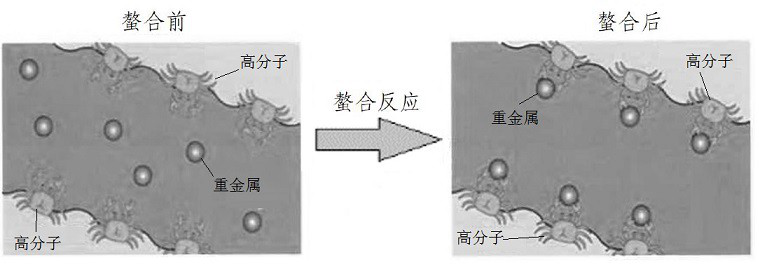A method for stabilizing and solidifying mercury-containing waste salt slag by using petrochemical waste alkali slag
A technology of waste salt residue and waste alkali residue, applied in the direction of protection devices against harmful chemicals, etc., can solve the problems of reduced mercury migration, poor stabilization effect, large capacity expansion ratio, etc., and achieves good stability and solidification effect. Simple, small capacity increase ratio
- Summary
- Abstract
- Description
- Claims
- Application Information
AI Technical Summary
Problems solved by technology
Method used
Image
Examples
Embodiment 1
[0050] Mercury-containing waste salt slag: Salt content 68%, water content 5.5%, mercury leaching concentration 73.5mg / l, the content is much higher than the mercury control limit of 0.25mg / L in the "Hazardous Waste Landfill Pollution Control Standard". The stabilization and solidification of mercury-containing waste salt slag is completed according to the following steps:
[0051] (1) Take 5000g of mercury-containing waste salt slag and put it into the first-stage ball mill continuously for one-stage mixing ball milling. At the same time, continuously add the main stabilizer-petrochemical waste alkali slag 750g in atomization mode, and the first-stage mixing ball milling time is 15min. After the material is discharged, it is continuously loaded into the second-stage ball mill and enters the second-stage ball mill. At the same time, the auxiliary stabilizer-heavy metal scavenger 1#5g is continuously added in the form of atomization, and the second-stage mixing and ball milling ...
Embodiment 2
[0055] Mercury-containing waste salt slag: Salt content 68%, water content 5.5%, mercury leaching concentration 73.5mg / l, the content is much higher than the mercury control limit of 0.25mg / L in the "Hazardous Waste Landfill Pollution Control Standard". The stabilization and solidification of mercury-containing waste salt slag is completed according to the following steps:
[0056] (1) Take 5000g of mercury-containing waste salt slag and put it into the first-stage ball mill continuously for a stage of mixed ball milling. At the same time, continuously add the main stabilizer-petrochemical waste alkali slag 250g in the form of atomization, and the first stage of mixed ball milling time is 15min. Continuously put into the second-stage ball mill and enter the second-stage ball mill. At the same time, continuously add auxiliary stabilizer-heavy metal scavenger 1#25g in the form of atomization, and the second-stage mixing ball milling time is 20min.
[0057] (2) Put the mixed mate...
Embodiment 3
[0060] Mercury-containing waste salt slag: Salt content 68%, water content 5.5%, mercury leaching concentration 73.5mg / l, the content is much higher than the mercury control limit of 0.25mg / L in the "Hazardous Waste Landfill Pollution Control Standard". The stabilization and solidification of mercury-containing waste salt slag is completed according to the following steps:
[0061] (1) Take 5000g of mercury-containing waste salt slag and put it into the first stage of ball mill continuously for a stage of mixed ball milling. At the same time, continuously add the main stabilizer-500g of petrochemical waste alkali slag in the form of atomization, mix and ball mill for 15 minutes, and continue after discharging. Put it into the second-stage ball mill and enter the second-stage ball mill. At the same time, add auxiliary stabilizer-heavy metal scavenger 1#15g continuously by atomization, and the second-stage mixing ball milling time is 20min.
[0062] (2) Put the mixed material af...
PUM
 Login to View More
Login to View More Abstract
Description
Claims
Application Information
 Login to View More
Login to View More - R&D Engineer
- R&D Manager
- IP Professional
- Industry Leading Data Capabilities
- Powerful AI technology
- Patent DNA Extraction
Browse by: Latest US Patents, China's latest patents, Technical Efficacy Thesaurus, Application Domain, Technology Topic, Popular Technical Reports.
© 2024 PatSnap. All rights reserved.Legal|Privacy policy|Modern Slavery Act Transparency Statement|Sitemap|About US| Contact US: help@patsnap.com










